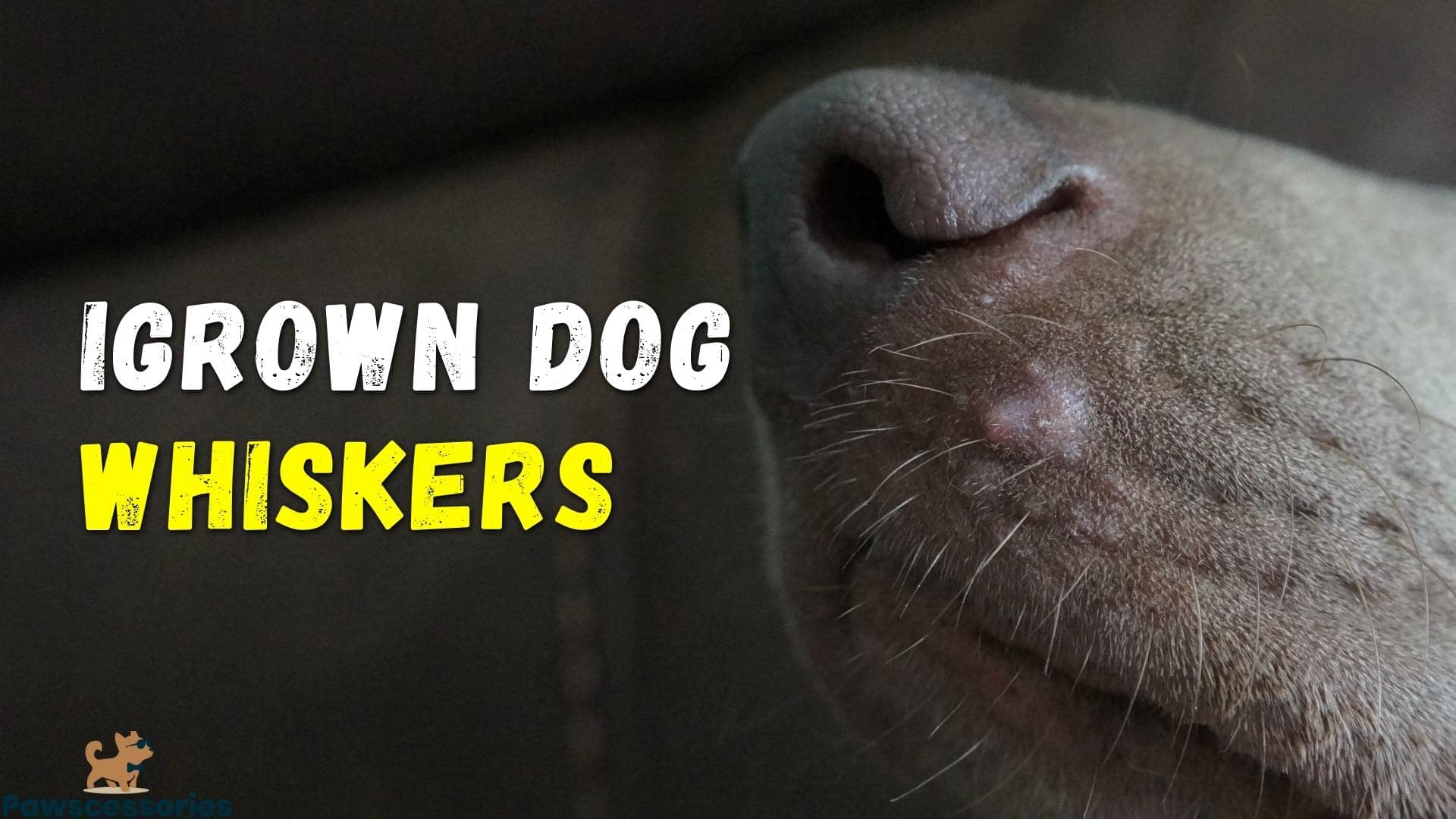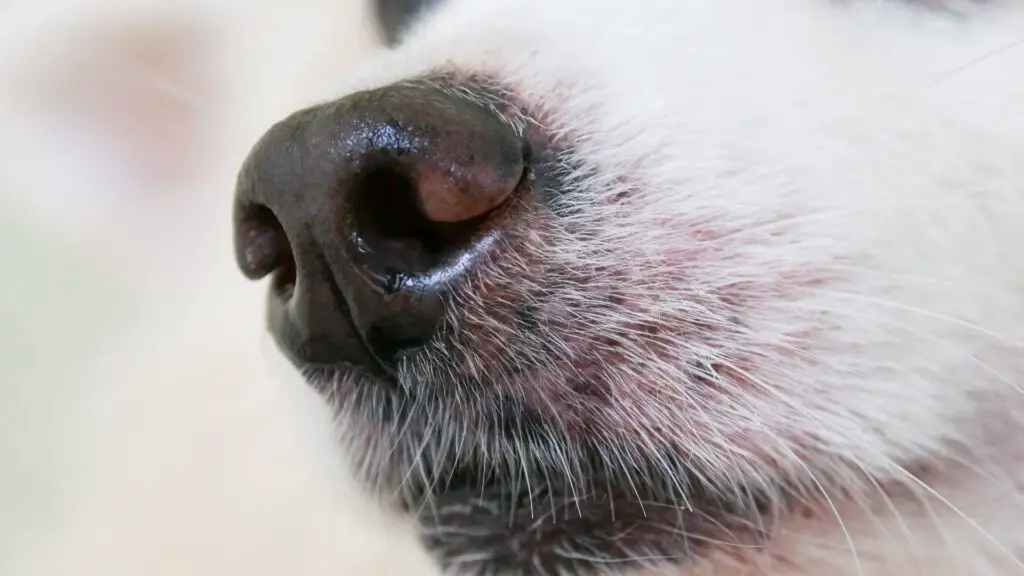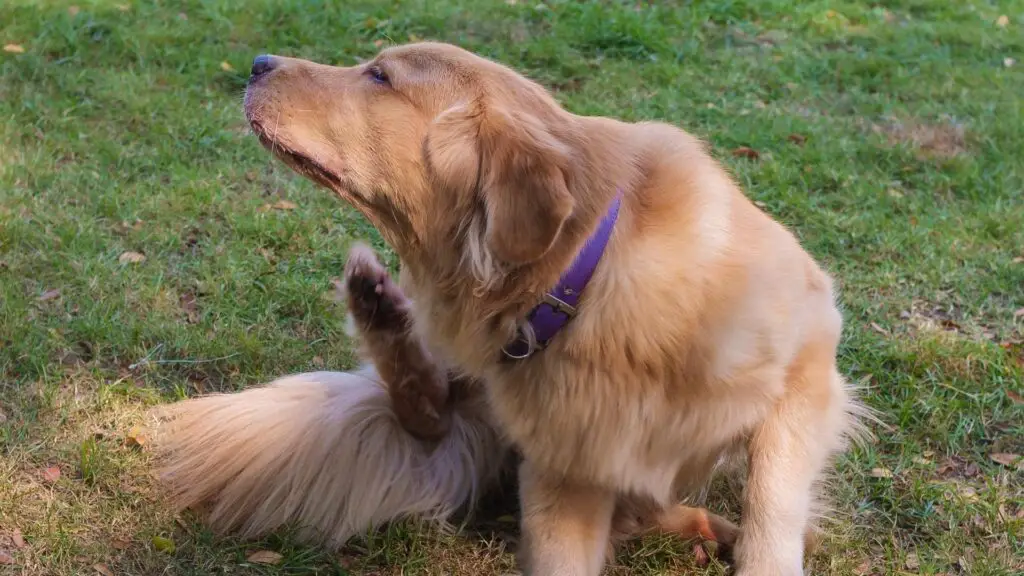Pawscessories is reader-supported. When you buy via links on our site, we may earn an affiliate commission at no cost to you.
Learn more.
Staring at my dog’s face, I noticed he had a little red bump on his face. What I didn’t realize was this bump was actually an ingrown dog whisker.
My father Dr. Littlejohn, pointed it to me when he visited. I asked him how this happened, how to treat it, and how to ensure it never happens again. He gave me some insights, and I created this post to help you the same way he helped me.
In this article, you’ll discover:
- How a dog might get an ingrown dog whisker
- A few ways to identify an ingrown hair vs. other conditions
- How to treat and heal ingrown hairs
- Ways to prevent your dog from developing ingrown hairs
Let’s dive in.
Table of Contents

What Is An Ingrown Dog Whisker?
An ingrown dog whisker is hair that has grown back into the skin. Dog whiskers that struggle to break out of the skin end up growing sideways under the skin.
Once the ingrown hair starts to grow under the skin, it begins twisting and starts to cause irritation, redness, and swelling. It can even cause an infection if it’s left untreated.
An ingrown dog whisker is the same as a regular ingrown hair, but since whiskers are generally longer and stiffer, they can be more prominent and uncomfortable for dogs.
In addition, since dogs have thick hair covering most of their body, dogs are naturally more prone to hair follicle problems and infections.
This is even more likely in double-coated dog breeds.
The problem most dog owners face is determining if the issue is, in fact, an ingrown hair or if it’s another skin condition that mimics ingrown hair symptoms.
How To Tell If Your Dog Has An Ingrown Dog Wisker
There are some common signs that your dog has an ingrown whisker.
The most obvious is a small bump or pimple-like growth on their face and mouth area.
These bumps are usually red, itchy, and might even be painful for your pup.
Here’s a list of symptoms to look for:
- Excessive scratching of the affected area
- Reddish color and a lump on the skin
- Swelling and hair loss around the ingrown hair
- Infected whiskers can produce pus if the hair gland gets infected
However, as mentioned, some of these symptoms could also point to other skin conditions.
For example, acne, folliculitis, mange, cysts, and urticaria could all be mistaken for ingrown hairs.
Acne is commonly found on the chin or thin skin of the belly.
Folliculitis is an infection around the hair shaft, which can give a dog coat a moth-eaten appearance.
Mange comes from mites that burrow deep into the skin.
Urticaria is an allergy that develops on the skin that results in itchy raised patches.
These can all mask an ingrown dog whisker, so it’s always best to get an expert to properly examine your dog and rule out any other possible issues.
Ingrown Whisker Cysts & Tumors
It’s also possible that what you’re seeing is not an ingrown hair but a cyst or tumor.
Cysts are sacs of fluid that can form under the skin and often don’t require treatment unless they get infected or become painful.
Tumors, on the other hand, are growths of tissue that could be cancerous or benign.
Suppose you suspect your dog has a cyst or tumor. In that case, it’s important to have them examined by your veterinarian as soon as possible.
How Do Dogs Get Ingrown Hairs?

There are a number of ways a dog can get an ingrown whisker or ingrown hair.
Here are a few ways a dog can develop ingrown hairs:
#1 Improper Growth
As I’ve already mentioned, one way is just by improper hair growth. The whisker just never broke through the skin and continued to grow underneath.
#2 Poor Grooming Habits
Ingrown hairs can also result from poor grooming habits. If you’re not properly brushing and detangling, your dog’s coat ingrown hairs are more likely to happen.
Not only that, but if you’re using the wrong type of brush or comb, this can also lead to ingrown hairs.
You see, certain types of brushes and combs can actually damage your dog’s hair follicles.
This damage makes it more likely for ingrown hairs to form.
#3 Trauma To The Skin
Another way dogs can get ingrown whiskers is by trauma to the skin.
This trauma can be caused by excessive scratching, rubbing, or even biting the skin.
It could also be caused by something as simple as your dog’s collar.
If the collar is too tight, it can rub and irritate the skin, causing ingrown hairs.
Anything that could cause trauma to the skin can damage the hair follicle and promote ingrown hair formation.
#4 Medical Conditions
In some cases, ingrown whiskers are caused by underlying medical conditions.
For example, certain skin conditions like seborrhea can cause ingrown hairs.
Seborrhea is a common skin condition in dogs that results in an overproduction of oil.
This excess oil can clog the hair follicles and cause ingrown hairs.
In addition, Infections, allergies, and even foreign bodies like grass awns can also cause ingrown whiskers in dogs.
All of these things can cause irritation and inflammation that makes it more likely for ingrown hairs to form.
So if you are confident your dog has an ingrown whisker, how do you treat it?
Let’s find out.
How To Treat A Dogs Ingrown Wisker
The good news is that ingrown whiskers are fairly easy to treat at home with some simple home remedies.
In most cases, you won’t even need to take your pup to the vet unless the ingrown hair becomes infected or starts causing your dog a lot of pain.
Before we get into the home remedies for ingrown dog hairs, the first thing you want to do is stop your dog from making the situation worse.
This means stopping them from scratching or itching the area. This only makes things worse, so get this under control first.
Once that’s done, you can apply some of these popular methods for naturally treating ingrown dog whiskers:
Warm compress: Applying a warm compress for 15-20 minutes a few times a day can help soothe the area and encourage the ingrown hair to break through the skin. You can also try using a warm salt water compress to help unclog hair follicles that have become clogged with debris, trapping the hair.
Epsom salt soak: Adding epsom salt to your dog’s bath can help draw out the ingrown hair. Just make sure you don’t use too much salt as it can be irritating to your dog’s skin.
Apple cider vinegar: Applying a small amount of apple cider vinegar to the affected area can also help. The acidity will help to draw out the ingrown hair while also helping to reduce inflammation and itchiness.
Aloe vera: Aloe vera is another popular home remedy for ingrown whiskers in dogs. It has natural anti-inflammatory properties that can help reduce swelling and discomfort.
After you’ve tried some of these methods, if nothing seems to work, the best plan of action is to physically remove them.
A vet will use a scalpel or tweezers to dislodge the embedded hair follicles to treat this ingrown hair.
You can try this yourself with tweezers, but it’s usually best to let the expert do it. This is especially true if there is an infection present.
If there’s an infection, your dog may need antibiotics or a steroid to help with the inflammation.
If you’re ever unsure, always consult your veterinarian for the best course of action.
They will be able to properly examine your pup, treat them, and rule out any other possible issues.
In addition, they can also prescribe medication if necessary to help treat the ingrown hair and reduce inflammation.
How To Prevent Your Dog From Getting Ingrown Whiskers

The best way to deal with ingrown whiskers is to prevent them from happening in the first place.
Here are 6 tips for preventing ingrown whiskers in dogs:
Proper Grooming
As we mentioned before, one of the most common causes of ingrown whiskers is poor grooming habits. Make sure you’re brushing and detangling your dog’s coat regularly to help prevent ingrown hairs.
Use The Right Brush
It’s also important to use the right brush for your dog’s coat type. If you’re not sure what kind of brush to use ask your groomer or vet for recommendations.
Avoid Shaving
Shaving your dog’s fur down too short can also make them more susceptible to ingrown whiskers. This is because when the hair starts to grow back, it can grow back into ingrown. If you must shave your dog, make sure you don’t go too short and always use sharp, clean scissors or clippers.
Don’t Overbath
Bathing your dog too often can also strip away the natural oils in their coat that help protects against ingrown whiskers. Stick to washing them every few weeks or as needed, and always use a gentle, hypoallergenic shampoo.
Check For Ingrown Hairs Regularly
Inspect your dog’s coat regularly for ingrown whiskers. If you find any, try to remove them right away before they have a chance to get infected.
Don’t Pop Your Dogs Bumps
Popping your dog’s pimples, ingrown whiskers, or any other bumps can cause them to become infected. If you see a bump on your dog’s skin, leave it alone and let the vet look at it.
Usually, the bumps sort themselves out naturally and popping them just worsens things.
Frequently Asked Questions
Do Ingrown Hairs Hurt Dogs?
While ingrown whiskers don’t usually cause dogs a lot of pain, they can be itchy and uncomfortable. If an ingrown hair becomes infected it can cause your dog a lot of pain and discomfort.
Should I Remove My Dogs Ingrown Hair?
If you can see the ingrown hair and it’s not infected you can try to remove it at home. If it’s infected or you’re not sure how to remove it, the best thing to do is take your dog to the vet.
They will be able to properly examine your pup and remove the ingrown hair without causing them any pain.
What Are The Bumps Under Dogs Whiskers?
The bumps under a dog’s whiskers are likely ingrown hairs. When the hair follicles become embedded in the skin they can cause irritation and swelling. If you notice any bumps under your dog’s whiskers make an appointment with your vet to have them checked out.
Other posts you might find interesting:
16 Ways To Know If Your Dog Is Sick
